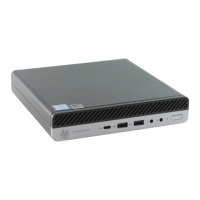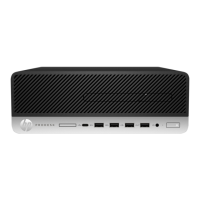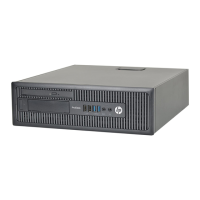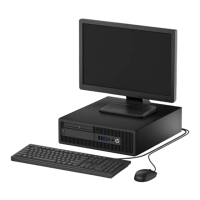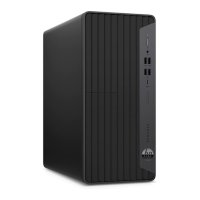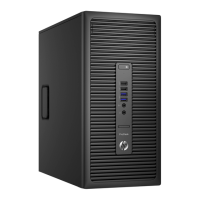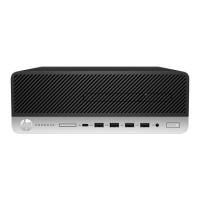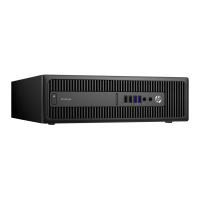
Do you have a question about the HP ProDesk 600 G5 MT and is the answer not in the manual?
| Chipset | Intel Q370 |
|---|---|
| Memory | Up to 64 GB DDR4-2666 SDRAM |
| Processor Options | Intel Core i3/i5/i7, Pentium, Celeron |
| Storage Options | HDD, SSD, NVMe SSD |
| Graphics | Integrated Intel UHD Graphics, Optional discrete graphics |
| Expansion Slots | PCIe x16, PCIe x1, M.2 |
| Ports | USB 3.1, RJ-45 |
| Networking | Integrated Intel I219-LM GbE |
| Operating System | Windows 10 Pro, Windows 10 Home, FreeDOS |
| Dimensions | 6.69 x 13.3 x 10.79 in |
Details on the standard hardware and software configuration.
Identification and description of components on the front panel of the computer.
Identification and description of components on the rear panel of the computer.
Location of the unique serial and product ID numbers on the computer.
Comprehensive list and descriptions of the computer's main components.
List of various additional parts, including power cords and adapters.
Precautions and information regarding electrostatic discharge (ESD) risks.
Measures to protect electronic components from ESD damage.
Equipment and methods for personal grounding to prevent static discharge.
Guidelines for setting up a static-safe work environment.
List of recommended grounding equipment for ESD prevention.
Instructions for operating the computer to prevent overheating and prolong life.
Procedures for cleaning the computer, keyboard, and mouse.
Important considerations for computer disassembly and assembly.
Safety precautions and steps before disassembling the computer.
Steps for removing and replacing the computer's access panel.
Procedure for removing and replacing the optical drive.
Procedure for removing and replacing the dust filter.
Steps to remove and replace the front bezel of the computer.
Procedures for removing and replacing 2.5-inch and 3.5-inch hard drives.
Steps for removing and replacing the computer's drive cage.
Procedure for removing and replacing the hood sensor switch.
Steps to remove and replace the computer's fan.
Procedure for removing and replacing the WLAN module.
Steps for removing and replacing the solid-state drive.
Procedure for removing and replacing memory modules.
Steps to remove and replace the internal speaker.
Procedure for removing and replacing the computer's power supply.
Steps to remove and replace the fan-sink assembly.
Procedure for removing and replacing the processor.
Steps for removing and replacing the system board.
Procedure for removing and replacing the connector board.
Overview of functions and capabilities of the Computer Setup utility.
Step-by-step guide on how to access and navigate the Computer Setup utility.
Details on the 'Main' section of Computer Setup, including system information.
Options for setting passwords and configuring security features in BIOS.
Advanced configuration options for system settings and boot behavior.
Method for saving and restoring system configuration settings.
Information on safe work environment and user comfort.
Steps to take to isolate problems before contacting support.
General suggestions for resolving common computer issues.
Common problems and their solutions for general system issues.
Troubleshooting steps for display and monitor-related issues.
Solutions for issues related to media card readers and cards.
Troubleshooting steps for audio output and input issues.
Common problems and solutions for printer connectivity and functionality.
Troubleshooting steps for keyboard and mouse input devices.
Guidance for resolving issues after installing new hardware.
Troubleshooting steps for network connectivity and controller issues.
Common software issues and their resolutions.
Solutions for issues related to RAM installation and performance.
Troubleshooting steps for USB flash drive recognition and boot issues.
Solutions for issues with front panel devices like USB or audio.
Troubleshooting steps for connecting to the Internet and web browsing.
List of POST error codes, messages, and recommended actions.
Guide to understanding system diagnostic LED and beep codes.
Procedures for clearing CMOS settings and resetting BIOS passwords.
Steps to modify or set up BIOS administrator and power-on passwords.
Procedures for removing existing BIOS setup and power-on passwords.
Instructions for downloading diagnostic tools to a USB drive.
Methods for backing up personal data and creating recovery media.
Procedures for restoring, resetting, and refreshing the computer.
Information on using HP Sure Recover for OS restoration.
Steps to restore nonvolatile memory and clear BIOS settings.
FAQ section covering BIOS, UEFI, memory, and security.
General requirements for power cord sets applicable to all countries.
Specific power cord requirements for different countries.




